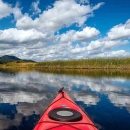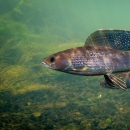
An endemic population of Arctic grayling (Thymallus arcticus) within the Red Rock Lakes Wilderness has declined and is at risk of extirpation. The population is subject to many factors limiting their abundance. Studies have indicated that the population has declined to a point where it is losing genetic diversity, which is decreasing its persistence, and increasing its risk of extirpation. From a wilderness perspective, extirpation would degrade the Natural wilderness character. For centuries this grayling population has lived alongside beaver (Castor canadensis) and has had to negotiate beaver dams to access spawning habitat. Today however, there are many additional factors (e.g. a warming climate, predation by, and competition with adult non-native Yellowstone cutthroat trout, etc.) that are also weighing on the population. Modeling has indicated that access to quality spawning habitat is important to this population, with spawning habitat being the secondary driver of grayling populations. Poor spawning access: affects reproductive success, is especially harmful at low abundances, and can lead to rapid demographic and genetic losses and the likelihood of extirpation.



